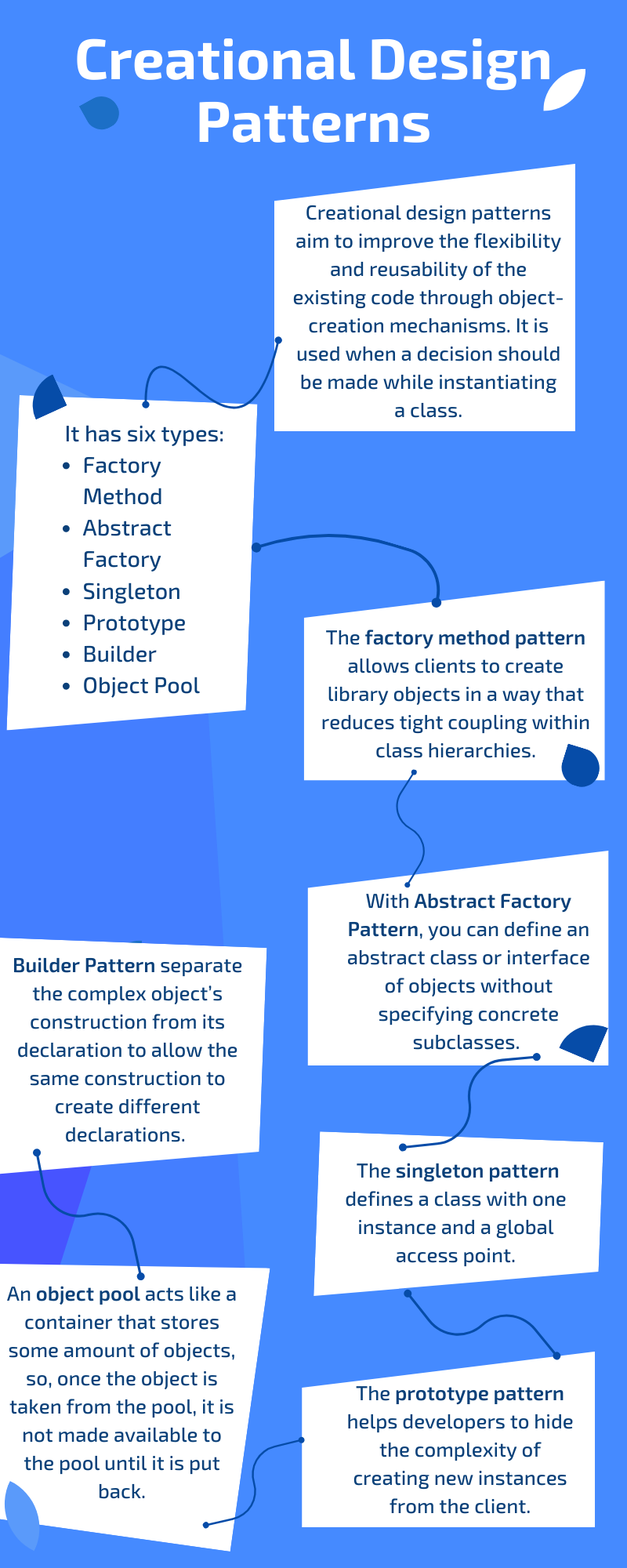In programming, design patterns help solve general, repetitive problems that developers encounter. It is not a code, rather it's a proven and tested paradigm used to prevent subtle issues.
Simply put, design patterns are blueprints for software development that developers can customize to solve a recurring code problem.
That being said, you can’t just find a pattern to copy and paste into your code. But, you can follow the details of the pattern and implement a solution that is ideal for your program.
Read: Design Patterns in Java
Design patterns are classified into three categories, Creational Design Pattern, Behavioural Design Pattern, and Structural Design Pattern, based on the problems they solve.
In today’s blog, we will discuss the creational design patterns and understand their subcategories. So, without further ado, let’s begin!
What is Creational Design Pattern?
Creational design pattern aims to improve the flexibility and reusability of the existing code through object-creation mechanisms. It is used when a decision should be made while instantiating a class.
Read: Custom Web Application Design Patterns
Moreover, creational design patterns minimized the instabilities and complexities in the program by creating controlled objects. The two dominant ideas behind this design pattern are information encapsulation about the classes a system uses and hiding instances about how classes are created and merged.
Read: Types of Software Architecture Patterns
Overall, Creational design patterns deal with object/class creation, support a simple yet controlled mechanism, allow detailed encapsulation, and encourage interface usage to reduce tight coupling.
Types of Creational Design Patterns
Now that we have a better understanding of what creational design patterns are. Let’s look at the types of creational design patterns in the market and their purposes.
-
Factory Method Pattern
In the factory method, objects are created without exposing the instantiation logic to the client, then the client uses the same interface to create a new object type. The idea behind the factory method is to use a static function to create and return instances while encapsulating the class modules’ details from the client.
Moreover, the factory method pattern allows clients to create library objects in a way that reduces tight coupling within class hierarchies.
Read: Factory Design Patterns in Java
To implement a factory method pattern in Java, developers need to define the factory method inside the interface, allow the subclass to implement the factory method, and create the required object.
Although Java doesn’t have polymorphic constructors, allowing subclasses to create an object, we are adding pseudo polymorphism.
-
Abstract Factory Pattern
It is almost similar to the factory method pattern that acts as another abstraction layer over the factory method. With Abstract Factory Pattern, you can define an abstract class or interface of objects without specifying concrete subclasses.
Read: When to Use Composite Design Pattern in Java
Also known as Kit, Abstract Factory enables a class to return factory classes. It eases the object family exchange and promotes object consistency.
Abstract Factory pattern is used when a developer wants a system to be independent of the way its objects are instantiated, arranged, and represented. Some other uses of the abstract factory are
-
When developers want to offer a library of objects that shows interfaces but hides implementations.
-
When they need to use related objects family together.
-
When one of the multiple objects’ families is needed to configure a software system.
Moreover, using abstract factory patterns helps in the isolation of concrete classes, promoting product consistency, and exchanging product families.

-
Singleton Pattern
This creational design pattern restricts the instantiation of a class to an object/singular instance. In simple terms, the singleton pattern defines a class with one instance and a global access point.
Read: What is the Iterator Design Pattern
Singleton pattern has two forms, namely, early instantiation (where instances are created at load time) and lazy instantiation (where instances are created when needed).
The major advantage of the singleton pattern is that it saves memory by not creating objects at every request and using a single instance repeatedly. It is one of the most popular design patterns used in the database and multi-threaded applications for caching, logging, thread pools, etc.
-
Prototype Pattern
A prototype helps developers to hide the complexity of creating new instances from the client. The basic concept behind the prototype pattern is to replicate an existing object instead of instantiating a new one from the start. As the existing object acts as a prototype, containing an object’s state, the newly replicated object might change its properties if required.
Read: What is facade design pattern in Java
Developers can use prototype patterns when they want to reduce the time and cost spent to create objects. Prototype lets you incorporate new product classes into a system through a prototypical instance, allowing clients to add or remove prototypes at run type, specify new objects by varying values and structure, and reduce subclasses that make it more flexible than other creational patterns.
-
Builder Pattern
This pattern aims to separate the complex object’s construction from its declaration to allow the same construction to create different declarations. Using the builder pattern offers you a flexible solution to multiple problems in object creation.
With the builder pattern, one can solve problems such as the way a class can construct different representations of a complex object, and the way creating a complex object can be simplified.
Read: What is the proxy design pattern in Java
The creation and assembling of complex objects are encapsulated in a separate Builder object, where a class delegates the creation of the builder object.
Providing clear separation between objects’ representation and constructors, offering better construction process control, and supporting internal object representation change are some of the advantages that the builder pattern offers.
-
Object Pool Pattern
Object pool acts like a container that stores some amount of objects, so, once the object is taken from the pool, it is not made available to the pool until it is put back. The lifecycle of an object consists of creation, validation, and destruction.
Read: What is Mediator Design Pattern
It is used to manage the caching of the object. A user who has access to the object pool doesn’t have to worry about creating a new object as they can simply take the one that’s already created.
Object pool pattern aims to reuse an object that is expensive to create. It helps in boosting the application performance by managing the connections and the way to share and reuse them.
Takeaway
So that was all about creational design patterns. We hope it helped you understand the basic concepts of creational patterns and their types. Remember this blog only scratches the surface of creational patterns and there’s much more to learn.
Besides, if you want to use creational patterns in your project, then feel free to get in touch with our team of experts. All you need to do after getting started is share a general idea of the project and your requirements and our experts will share a customized quote to hire developers.
FAQs
Q1. What are creational design patterns in Java?
Creational design patterns deal with object/class creation, support a simple yet controlled mechanism, allow detailed encapsulation, and encourage interface usage to reduce tight coupling.
Q2. Which are creational design patterns?
Factory method patterns, abstract factory patterns, singleton patterns, prototype patterns, builder patterns, and object pool patterns, all come under creational design patterns.
Q3. What are the 3 design patterns?
Creational Design Pattern, Behavioural Design Pattern, and Structural Design Pattern are the three design patterns used by developers to solve a recurring code problem.

